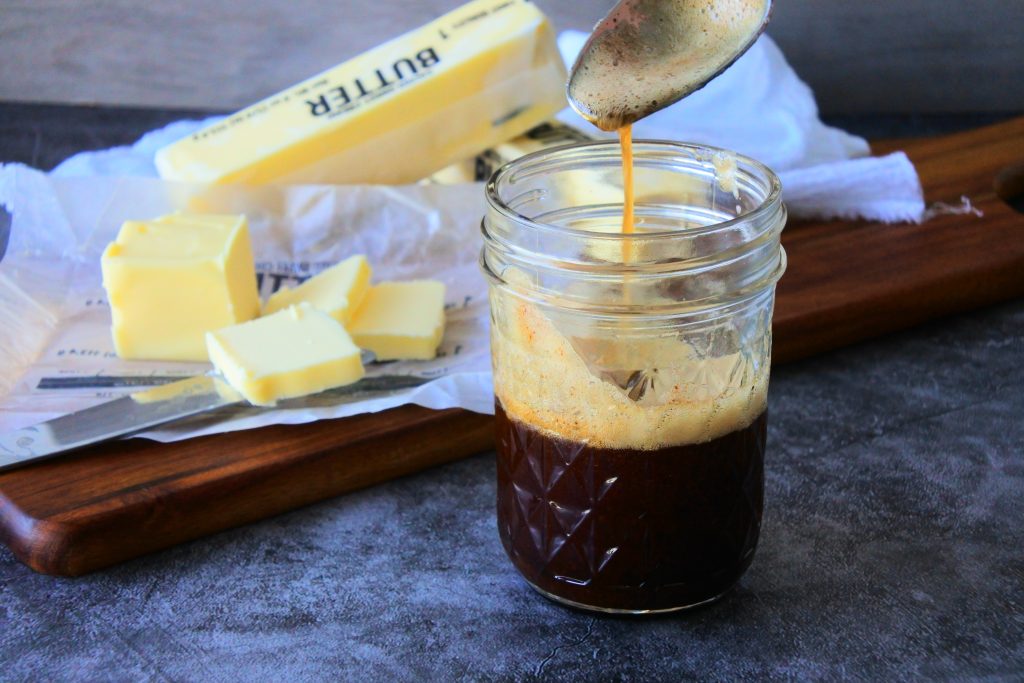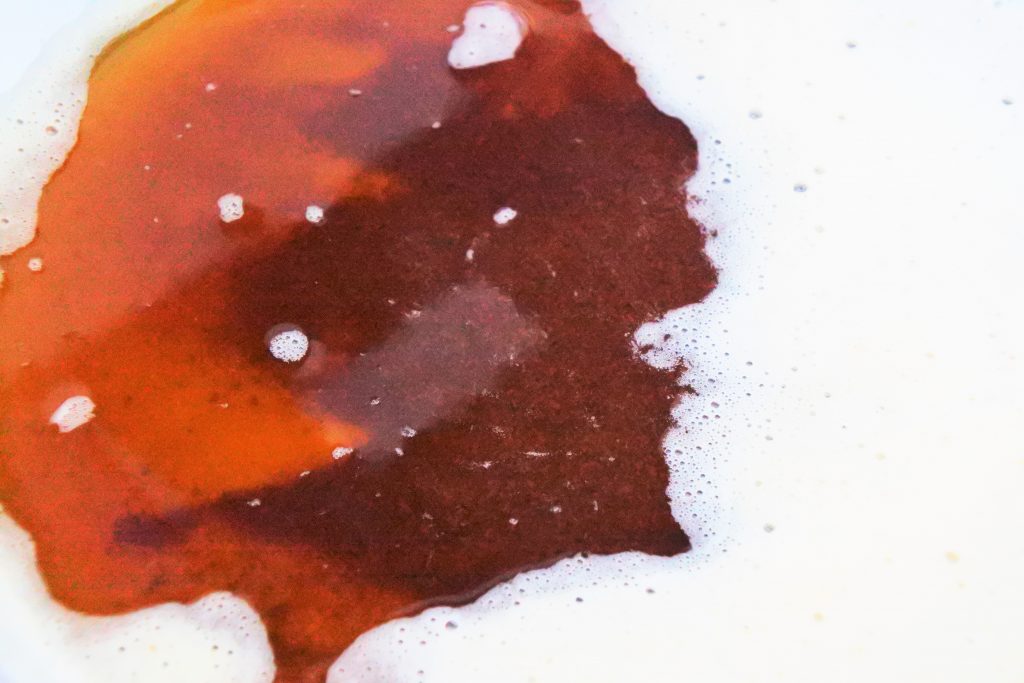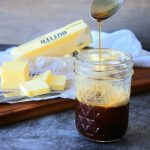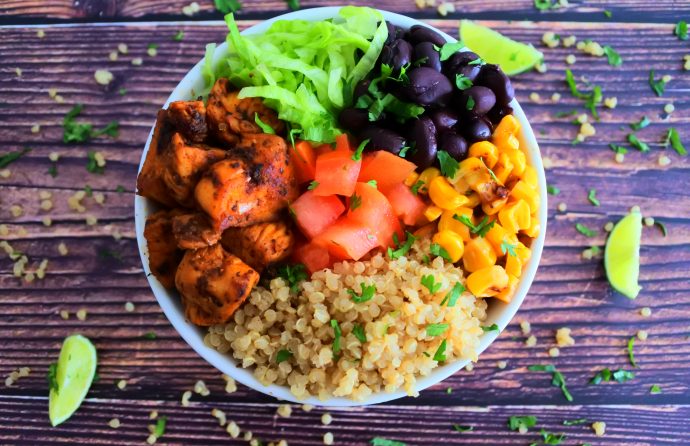Disclosure: This post may contain affiliate links.

Making brown butter is perhaps the easiest way you can upgrade any savory or sweet dish or baked good. It’s honestly one of those not-so-secret-culinary ingredients that might seem complicated but really takes about 5 minutes to make.
What is Brown Butter?🧈
Brown Butter is essentially butter that’s gently heated until it melts, separates and browns. The depth of the flavor depends on how deeply the butter is browned but you can expect a rich almost hazelnut-like nuttiness to your butter. This description perfectly aligns with the French term Beurre Noisette, which literally translates to hazelnut butter but loosely translates to brown butter, this term makes even more sense as your browned butter cools and begins to solidify, as you mix in the caramelized milk solids throughout it, it looks almost exactly like hazelnut butter!
Butter is made up of butterfat, milk solids, and water. As we heat it, the water evaporates leaving behind the butterfat and milk solids which will sink to the bottom of the pan and slowly brown and caramelize which results in a deeply rich and nutty, almost toffee-like, aroma and flavor.
Fun fact: the separation and removal of the milk solids (before they brown) from melted butter results in the creation of ghee aka clarified butter which is lactose-free!

What Do You Need to Make Brown Butter?
In short, you need just one ingredient: Butter! You can use salted or unsalted butter, though unsalted is the more traditionally used type.
How to Make Brown Butter:

Simply melt the butter in a light-colored skillet on a med-low heat and allow the milk solids to separate and brown/caramelize. That’s it! The whole process takes about 5-7 minutes.
As the butter melts it will begin to bubble and then it will create a froth. Ensure you’re stirring the butter every so often to evenly brown the separated milk solids and to keep an eye on the color. You can allow your butter’s color to range from a light golden honey to a deeper, earthier brown. The darker the butter the more complex and pronounced the nutty, toffee-like the depth of flavor.
Five Tips to Ensure Success!
- Use butter that’s not frozen or too cold. Room temperature is best. Similarly, start your butter off on lower heat. This minimizes splatter as the water in the butter evaporates. 🧈❌❄️
- Use a light colored pan. Stainless steel is most recommended. The reason for this is to allow you to see the color of the butterfat and milk solids. Dark pans such as Teflon coated pans do not allow you to see the true color of your butter. ⚪>⚫
- Be sure to gently swirl or use a utensil to agitate the melted butter to ensure that the milk solids are evenly browning and not burning on the bottom. 🥄🌪️
- Do not walk away from your butter, keep a close eye on it to ensure it doesn’t burn.❌🚶
- Once your ideal color is achieved, immediately transfer it to a heat-resistant jar or bowl. Leaving the butter in the pan will cause it to keep browning and you risk burning it or going past your preferred color/flavor.🍳>>🍯 ✔️
To Strain or Not to Strain?
This is entirely up to you. You can strain to remove the caramelized milk solids from your butter so that you’ve left with a browned butterfat, however note that the true depth of flavor complexity lies in those browned milk solids.

What Can You Use Brown Butter For/In?
You can use browned butter in any recipe that calls for butter if you want to add a more nutty and richer and deeper depth of flavor. Some options include:
- Use it as a spread on breads or even on your Homemade Naan.
- Use it as a sauce for pasta like this Homemade Gnocchi
- Drizzle it over freshly steamed rice
- In cookies like these Gluten Free Oatmeal Raisin Cookies, Classic Chocolate Chip Cookies, or these Drop Chocolate Chip Cookies.
- In cakes and brownies such as my Gluten Free Chewy Brownies or my Almond Flour Brownie Bites
- In pies/pie crusts like my Homemade Apple Pie
- As a finishing drizzle over steamed or roasted vegetables or tray bakes
- Add it to your Whole Wheat Buttermilk Pancakes or Gluten Free Pancakes or to your Gluten Free Waffle Batter.
- Add it to your Mashed Potatoes or the more carb-friendly Cauliflower Mash.
- Use it to make your Compound Butter richer and more complex.
Easy Brown Butter
Ingredients
- 1 stick salted butter or unsalted
Instructions
- To a light colored skillet, add your room temperature butter and set it onto med-low heat.
- As the butter melts it will bubble and then froth, be sure to stir it gently and keep an eye on it.
- Once the butter is light-golden brown and has a nutty aroma to it, remove it from the heat and immediately transfer it to a heat-resistant bowl or jar. If desired you can strain it to remove the milk solids.
- Use as desired. Store any leftovers in an airtight container in the fridge.
Notes
- You can scale this recipe to use as many sticks of butter as needed.
- Avoid using cold or frozen butter as that will make spattering more prevalent as the water in the butter evaporates.
- Keep an eye on your butter as it can go from brown to burnt quickly.
- Your butter will have a layer of froth on the top, you will need to gently push the froth aside to clear a space to see the butter. This is normal.
- If using in baked goods, allow your butter to cool to at least lukewarm first.
- If your butter has the milk solids in it they will sink to the bottom, be sure to stir your butter as it cools to incorporate the milk solids throughout as it solidifies.


